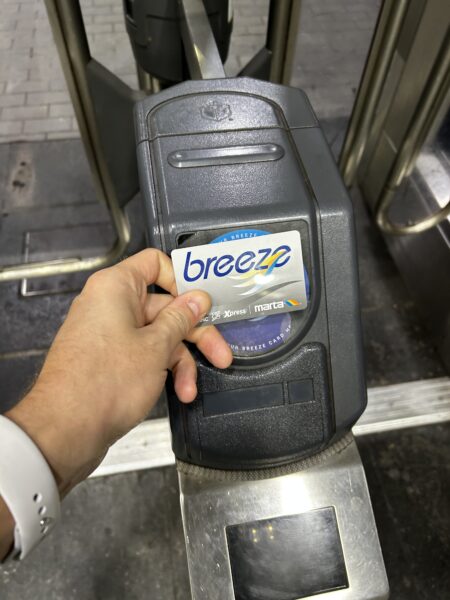Facing My Fears
I’ll admit it—I had my doubts about public transit. In my head, it was confusing, dirty, unreliable, and filled with questionable people. These ideas kept me alone in my car, maneuvering through traffic during rush hour, determined to avoid what I thought was a terrifying experience. But I finally faced my fear and decided to see for myself what it was all about, and my experience on public transit was an eye-opener.
What I discovered debunked not only the myths I believed but also my hesitation about using public transit. If you’re on the fence about trying public transit, let me share how these misconceptions were untangled for me and how riding transit connects to a larger goal—transportation demand management (TDM). TDM focuses on reducing traffic congestion and making commuting more efficient, and my experience with riding transit ties directly into those principles.
Myth #1: I Thought Public Transit Would Be Dirty
My number one biggest fear was the cleanliness of public transit. I assumed the train would be dirty and unpleasant. But when I stepped on board, I was surprised—it wasn’t bad at all! Sure, not every train is spotless, but the transit system clearly tries to keep things clean. It honestly wasn’t much different from what I’d expect in any public space.

Before I tried public transit, I thought it would be impossible to figure out the routes and schedules. It felt overwhelming compared to just hopping in my car and driving wherever I wanted. But once I tried it, I found that getting around was easier than I thought. Thanks to apps like Google Maps, you can track everything in real-time and plan your trip with ease.
Myth #2: I Thought Public Transit Would Be Too Confusing to Navigate
Learning how to navigate transit wasn’t just about personal convenience—it also helped me understand the larger effort to reduce congestion on the roads. TDM strategies encourage using modes of transportation like public transit to reduce traffic during rush hour. I found that by getting comfortable with riding the train, I was contributing to a system designed to keep traffic flowing for everyone.
Myth #3: I Expected to Run into the Unexpected
I admit that I had the idea that trains were filled with questionable people and unpredictable situations. And while you definitely come across a variety of personalities, it’s not as wild as I expected. In fact, it’s one of the things I’ve grown to appreciate.
When you’re driving, you’re stuck in your own bubble, cut off from the world. Public transit connects people from all walks of life in a shared experience, making commuting more social and less isolating. Beyond that, using public transit supports another key TDM principle—encouraging shared rides reduces the number of solo-person cars on the road, which means fewer emissions, less congestion, and a smoother commute for all.
Myth #4: I Thought Public Transit Would Be Slow and Unreliable
I assumed public transportation was slower than driving, but after trying it out, I realized that’s not the case. When you think about how much time you spend sitting in traffic, looking for parking, or stopping at endless red lights, riding transit actually saves you time.
Myth #5: I Worried Public Transportation Wouldn’t Be Safe
Safety was a big concern for me before riding public transit. I heard stories about crime and felt uneasy about the idea of public transit. But after riding a few times, I realized that these incidents are rare. There are security measures in place—cameras, security personnel, and well-lit stations, to name a few.
If anything, I started to think about the risks of driving: accidents, breakdowns, road rage, and various other hazards. Public transit started to feel like the safer option. As long as you stay aware of your surroundings, there’s no reason to feel unsafe. TDM aims to promote commuting choices while reducing the number of cars on the road. Fewer cars mean fewer traffic accidents, helping us all get around more safely.

Conclusion: My Take on Public Transportation
In the end, my experience with riding public transit was more than just debunking myths—it was about discovering a better way to get around. Public transit isn’t just about avoiding traffic stress—it’s a key part of a larger movement toward smarter, more sustainable commuting through TDM.
TDM strategies, like taking the train, help reduce traffic, improve air quality, and make cities more livable for everyone. So, if you’re still unsure about hopping on public transit, I say go for it. You might find, like I did, that the benefits—less traffic stress, more time to yourself, and a better way to support your community—are well worth the ride.
If you’re interested in learning more about TDM and how you or your company could benefit from it, contact Lisa Kay Schweyer, Foursquare ITP’s TDM service area lead.